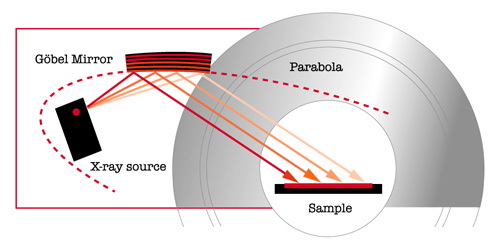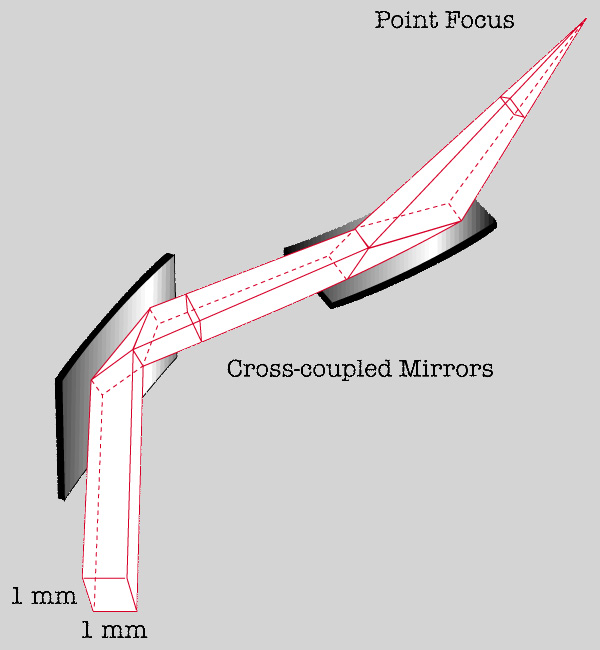![[ICON: To the NSR page]](../../../../graphics/nsrlogo.gif)
![[ICON: To the NSR page]](../../../../graphics/nsrlogo.gif)
![[ICON: To the RIM page]](../../../../graphics/rimlogo.gif)
 Unlike visible light, X-rays cannot be directed with conventional optical elements, such as refractive lenses. While total reflection mirrors, known as Franks’ Mirrors, can reflect an X-ray beam at angles of incidence below 0.1°, Bragg diffraction from crystals is the only way to influence the direction and divergence of an X-ray beam at higher incidence angles. With this method, a particular wavelength is diffracted only at particular angles, called Bragg angles. With conventional monochromator crystals, the X-ray beam can only be diffracted in well determined directions, but the divergent beam from the X-ray source cannot be effectively controlled. However, this becomes possible with Bragg diffraction from Göbel Mirrors.
Unlike visible light, X-rays cannot be directed with conventional optical elements, such as refractive lenses. While total reflection mirrors, known as Franks’ Mirrors, can reflect an X-ray beam at angles of incidence below 0.1°, Bragg diffraction from crystals is the only way to influence the direction and divergence of an X-ray beam at higher incidence angles. With this method, a particular wavelength is diffracted only at particular angles, called Bragg angles. With conventional monochromator crystals, the X-ray beam can only be diffracted in well determined directions, but the divergent beam from the X-ray source cannot be effectively controlled. However, this becomes possible with Bragg diffraction from Göbel Mirrors.
In contrast to conventional monochromator crystals, Göbel Mirrors are multilayer crystals manufactured so the spacing d between the layers varies in a controlled manner. The appropriate gradient in the d-spacing depends on factors which include wavelength, the location of the mirror with respect to the source, and the application for which the mirror is designed.

Göbel Mirrors generate a high intensity Ka beam cross section (high brilliance).
If a single parabolically bent Göbel Mirror is placed in the beam path so the line focus of the X-ray source is at the focus of the parabola, then approximately 1° of the divergent primary beam will be collected and transformed into a parallel beam (D8 X-ray diffractometer, upper picture).
For an X-ray source with point focus, a second Göbel Mirror turned 90° collimates the beam in the direction perpendicular to the first mirror (GADDS, SMART, and HI-STAR X-ray diffractometer, lower figure).
For all applications requiring strong collimation of the beam, Göbel Mirrors provide considerable intensity gains. These include investigations with
Added benefits of the parallel-beam geometry with Göbel Mirrors are no line broadening and no shifts in applications involving
A further advantage with Göbel Mirrors is the fast and easy change between different diffractometer configurations. For example:
| Goniometer | D500X | D8 | GADDS/SMART/HI-STAR | |
|---|---|---|---|---|
| Beam | parallel | parallel | parallel | |
| Focus | line focus | line focus | point focus | |
| Dimensions (mm) | 40x20 | 40x20 or 60x20 | 40x20 | 60x20 |
| d-spacing Range (Å) | 31-38 | 31-38 | 31-38 | 40-50 |
| Radiation | Cu/Co/Cr | Cu/Co/Cr | Cu | Cu |
| Angle of Acceptance | 0.6° | 0.6° | 0.6° | 1° |
| Average Diffracted Ka Intensity(%) | 65 | 65 | 65 | 75 |
| Beam Divergence | 0.05° | 0.05° | 0.05° | 0.05° |
| Beam Size (mm) | >0.5 | >0.5 | >0.5 | >0.5 |
| Monochromatization | Ka | Ka | Ka | Ka |